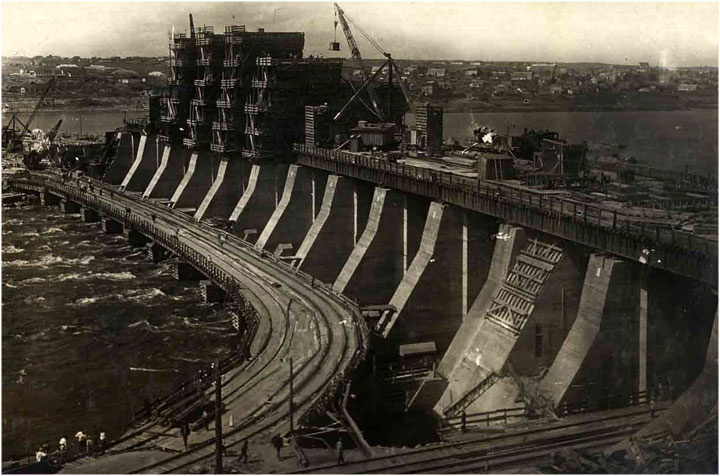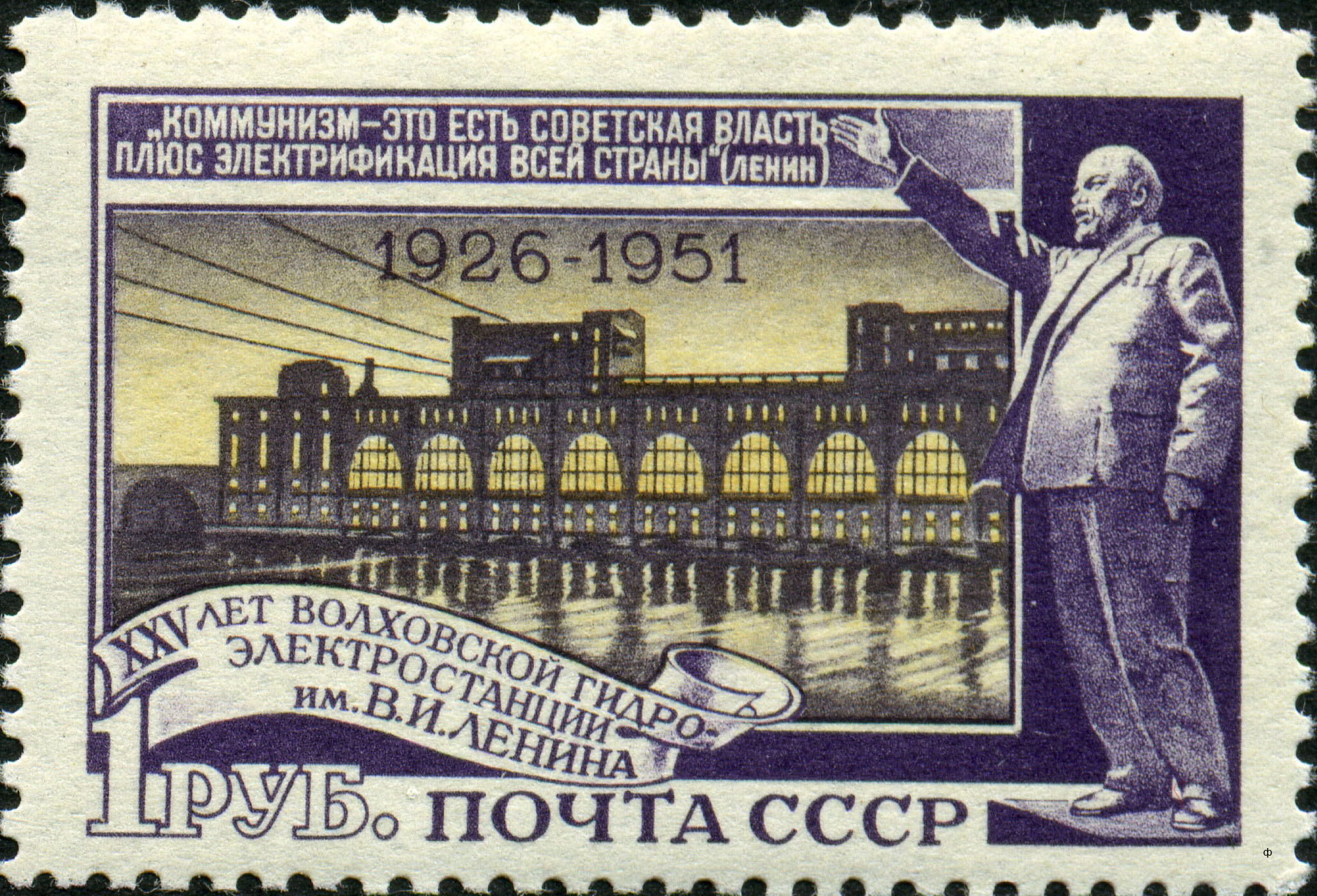|
DniproHES
The Dnieper Hydroelectric Station (), also known as the Dnipro Dam, is a hydroelectric power station in the city of Zaporizhzhia, Ukraine. Operated by Ukrhydroenergo, it is the fifth and largest station in the Dnieper reservoir cascade, a series of hydroelectric stations on the Dnieper river that supply power to the Donets–Kryvyi Rih industrial region. Its dam has a length of , a height of , and a flow rate of per second. The dam elevates the Dnieper river by and maintains the water level of the Dnieper Reservoir, which has a volume of 3.3 km3 and stretches upstream to the nearby city of Dnipro. The reservoir's two shipping canals—the disused original one with three staircase locks and a newer one with one staircase lock—allow ships to bypass the dam at its eastern end and sail upstream as far as the Pripyat River. A highway on the dam and bridge over the shipping canals enable vehicles to cross the Dnieper. The electric station was built by the Soviet Union ... [...More Info...] [...Related Items...] OR: [Wikipedia] [Google] [Baidu] |
Zaporizhzhia
Zaporizhzhia, formerly known as Aleksandrovsk or Oleksandrivsk until 1921, is a city in southeast Ukraine, situated on the banks of the Dnieper, Dnieper River. It is the Capital city, administrative centre of Zaporizhzhia Oblast. Zaporizhzhia has a population of Zaporizhzhia is known for the historic island of Khortytsia, multiple power stations and for being an important industrial centre. Steel, aluminium, aircraft engines, automobiles, transformers for substations, and other heavy industrial goods are produced in the region. Names and etymology The name ''Zaporizhzhia'' refers to the position of the city: "beyond the rapids"—downstream or south of the Dnieper Rapids. These were previously an impediment to navigation and the site of important portages. In 1932, the rapids were flooded to become part of the reservoir of the Dnieper Hydroelectric Station.Pospelov, pp. 25–26 Before 1921, the city was called Aleksandrovsk (or Oleksandrivsk), named after the original fort ... [...More Info...] [...Related Items...] OR: [Wikipedia] [Google] [Baidu] |
Dnieper
The Dnieper or Dnepr ( ), also called Dnipro ( ), is one of the major transboundary rivers of Europe, rising in the Valdai Hills near Smolensk, Russia, before flowing through Belarus and Ukraine to the Black Sea. Approximately long, with a drainage basin of , it is the longest river of Ukraine and Belarus and the fourth- longest river in Europe, after the Volga, Danube, and Ural rivers. In antiquity, the river was part of the Amber Road trade routes. During the Ruin in the later 17th century, the area was contested between the Polish–Lithuanian Commonwealth and Russia, dividing what is now Ukraine into areas described by its right and left banks. During the Soviet period, the river became noted for its major hydroelectric dams and large reservoirs. The 1986 Chernobyl disaster occurred on the Pripyat River, a tributary of the Dnieper, just upstream from its confluence with the Dnieper. The Dnieper is an important navigable waterway for the economy of Ukraine and i ... [...More Info...] [...Related Items...] OR: [Wikipedia] [Google] [Baidu] |
Gosplan
The State Planning Committee, commonly known as Gosplan ( ), was the agency responsible for economic planning, central economic planning in the Soviet Union. Established in 1921 and remaining in existence until the dissolution of the Soviet Union in 1991, Gosplan had as its main task the creation and administration of a series of Five-year plans of the Soviet Union, five-year plans governing the economy of the Soviet Union, economy of the USSR. History Economic background The time of the October Revolution and the Russian Civil War which followed was a period of virtual economic collapse. Production and distribution of necessary commodities were severely tested as factories were shuttered and major cities such as Petrograd (now Saint Petersburg) were depopulated, with urban residents returning to the countryside to claim a place in land redistribution and in order to avoid the unemployment, lack of food, and lack of fuel which had become endemic. By 1919 the country was in hype ... [...More Info...] [...Related Items...] OR: [Wikipedia] [Google] [Baidu] |
Ivan Alexandrov
Ivan Gavrilovich Alexandrov (Russian: Ива́н Гаври́лович Алекса́ндров; 1 September Old_Style_and_New_Style_dates.html" ;"title="nowiki/>O.S. 21 August1875 – 2 May 1936) was a Russian Empire">Russian and Soviet Union">Soviet engineer who played a significant role in the modernization of the Soviet Union. Career In 1920, Alexandrov participated in developing the GOELRO plan which was the electrification plan of the Soviet Union. From 1921 to 1927, he was Chief Engineer of the design organization (; ) and, in 1926, designed the Dnipr Dam on the Dnipr. From 1921, he headed the Regionalisation Committee of Gosplan and, as the director with support from Gleb Krzhizhanovsky, used rational economic planning rather than "the vestiges of lost sovereign rights" to divide the Soviet Union into thirteen European and eight Asiatic oblasts. He participated in the plan of the general scheme for the electrification of Slovenia, and, in Asia, the plan for the c ... [...More Info...] [...Related Items...] OR: [Wikipedia] [Google] [Baidu] |
Electrification
Electrification is the process of powering by electricity and, in many contexts, the introduction of such power by changing over from an earlier power source. In the context of history of technology and economic development, electrification refers to the build-out of the electricity generation and electric power distribution systems. In the context of sustainable energy, electrification refers to the build-out of super grids and smart grids with distributed energy resources (such as energy storage) to accommodate the energy transition to renewable energy and the switch of end-uses to electricity. The electrification of particular sectors of the economy, particularly out of context, is called by modified terms such as Mass production#Factory electrification, ''factory electrification'', ''household electrification'', ''rural electrification'' and ''railway electrification''. In the context of sustainable energy, terms such as ''transport electrification'' (referring to electric v ... [...More Info...] [...Related Items...] OR: [Wikipedia] [Google] [Baidu] |
GOELRO
GOELRO () was the first of Soviet Russia's plans for national economic recovery and development. It became the prototype for subsequent Five-Year Plans drafted by Gosplan. GOELRO is the transliteration of the Russian abbreviation for "State Commission for Electrification of Russia" (). The Commission and Plan were initiated and supervised by Vladimir Lenin. Lenin's belief in the central importance of electrification to the achievement of communism is represented by his statement: Foundation The commission was established by the Presidium of the VSNKh on February 21, 1920, in accordance with February 3, 1920, VTsIK resolution on the electrification plan development. The director of the commission was Gleb Krzhizhanovsky. About 200 scientists and engineers participated, including Genrikh Graftio, Ivan Alexandrov, Mikhail Shatelen and others. By the end of 1920 the Commission devised the "Russian SFSR Electrification Plan" (), that was approved subsequently by the 8th All-Rus ... [...More Info...] [...Related Items...] OR: [Wikipedia] [Google] [Baidu] |
USSR
The Union of Soviet Socialist Republics. (USSR), commonly known as the Soviet Union, was a List of former transcontinental countries#Since 1700, transcontinental country that spanned much of Eurasia from 1922 until Dissolution of the Soviet Union, it dissolved in 1991. During its existence, it was the list of countries and dependencies by area, largest country by area, extending across Time in Russia, eleven time zones and sharing Geography of the Soviet Union#Borders and neighbors, borders with twelve countries, and the List of countries and dependencies by population, third-most populous country. An overall successor to the Russian Empire, it was nominally organized as a federal union of Republics of the Soviet Union, national republics, the largest and most populous of which was the Russian SFSR. In practice, Government of the Soviet Union, its government and Economy of the Soviet Union, economy were Soviet-type economic planning, highly centralized. As a one-party state go ... [...More Info...] [...Related Items...] OR: [Wikipedia] [Google] [Baidu] |
History Of The Soviet Union (1927–53)
The history of the Soviet Union (USSR) (1922–91) began with the ideals of the Russian Bolshevik Revolution and ended in dissolution amidst economic collapse and political disintegration. Established in 1922 following the Russian Civil War, the Soviet Union quickly became a one-party state under the Communist Party. Its early years under Lenin were marked by the implementation of socialist policies and the New Economic Policy (NEP), which allowed for market-oriented reforms. The rise of Joseph Stalin in the late 1920s ushered in an era of intense centralization and totalitarianism. Stalin's rule was characterized by the forced collectivization of agriculture, rapid industrialization, and the Great Purge, which eliminated perceived enemies of the state. The Soviet Union played a crucial role in the Allied victory in World War II, but at a tremendous human cost, with millions of Soviet citizens perishing in the conflict. The Soviet Union emerged as one of the world's two s ... [...More Info...] [...Related Items...] OR: [Wikipedia] [Google] [Baidu] |
Khortytsia
Khortytsia (, ) is the largest island on the Dnieper River, and is long and up to wide. The island forms part of the Khortytsia National Reserve. This historic site is located within the city limits of Zaporizhzhia, Ukraine. The island has played an important role in the history of Ukraine, especially in the history of the Zaporozhian Cossacks. The island has unique flora and fauna, including oak groves, spruce woods, meadows, and steppe. The northern part of the island is very rocky and high (rising above the river bed) in comparison to the southern part, which is low, and often flooded by the waters of the Dnieper. Geography and location Zaporizhzhia (direct translation is "beyond the rapids") takes its name from a geographic area downstream of the Dnieper river past the ninth rapid (see Dnieper rapids). In the 1930s, when the Dnieper Hydroelectric Station was built, these rapids were flooded. Only granite cliffs, rising to the height of , testify to the original rock ... [...More Info...] [...Related Items...] OR: [Wikipedia] [Google] [Baidu] |
Colonel Hugh Lincoln Cooper
Colonel ( ; abbreviated as Col., Col, or COL) is a senior military officer rank used in many countries. It is also used in some police forces and paramilitary organizations. In the 17th, 18th, and 19th centuries, a colonel was typically in charge of a regiment in an army. Modern usage varies greatly, and in some cases, the term is used as an honorific title that may have no direct relationship to military. In some smaller military forces, such as those of Monaco or the Vatican, colonel is the highest rank. Equivalent naval ranks may be called captain or ship-of-the-line captain. In the Commonwealth's air force ranking system, the equivalent rank is group captain. History and origins By the end of the late medieval period, a group of "companies" was referred to as a "column" of an army. According to Raymond Oliver, , the Spanish began explicitly reorganizing part of their army into 20 ''colunelas'' or columns of approximately 1,000–1,250 soldiers. Each ''colunela'' was comm ... [...More Info...] [...Related Items...] OR: [Wikipedia] [Google] [Baidu] |






